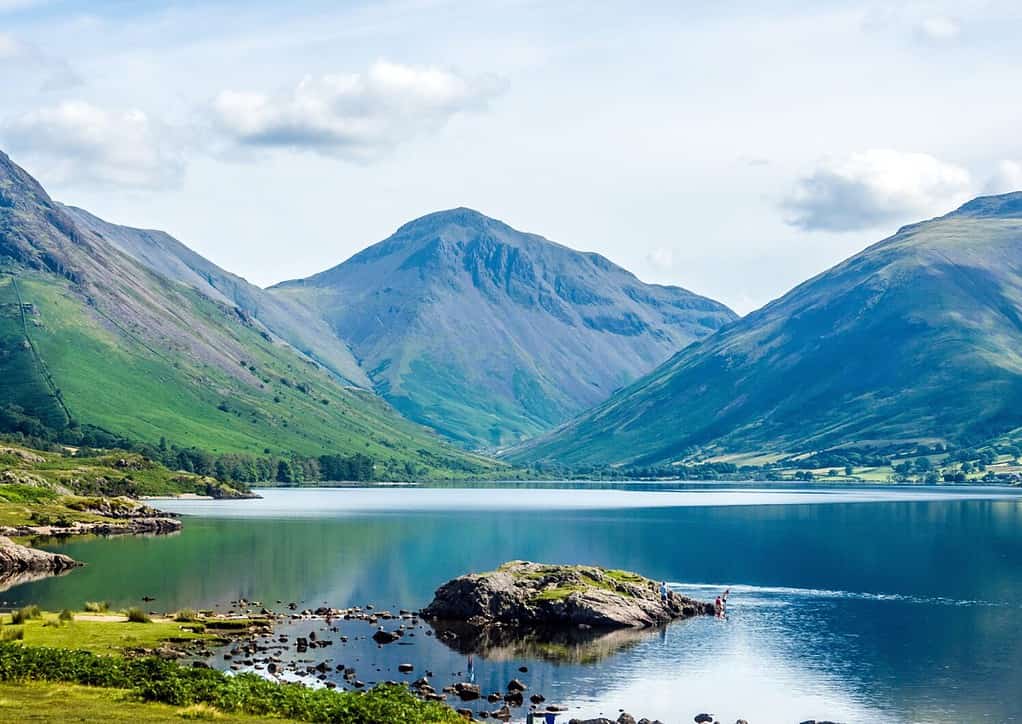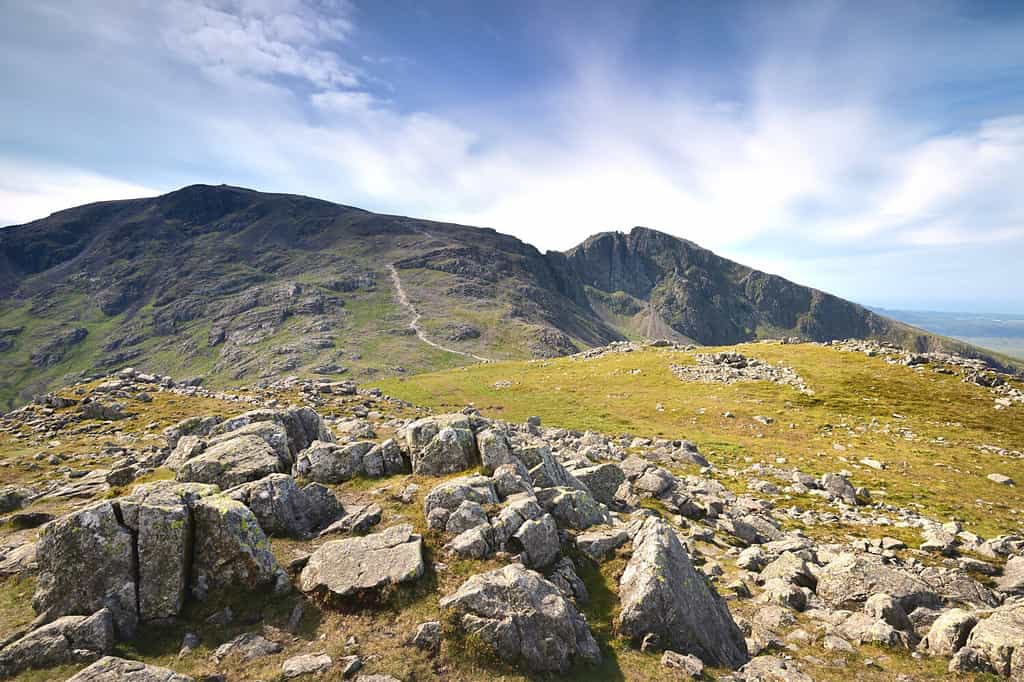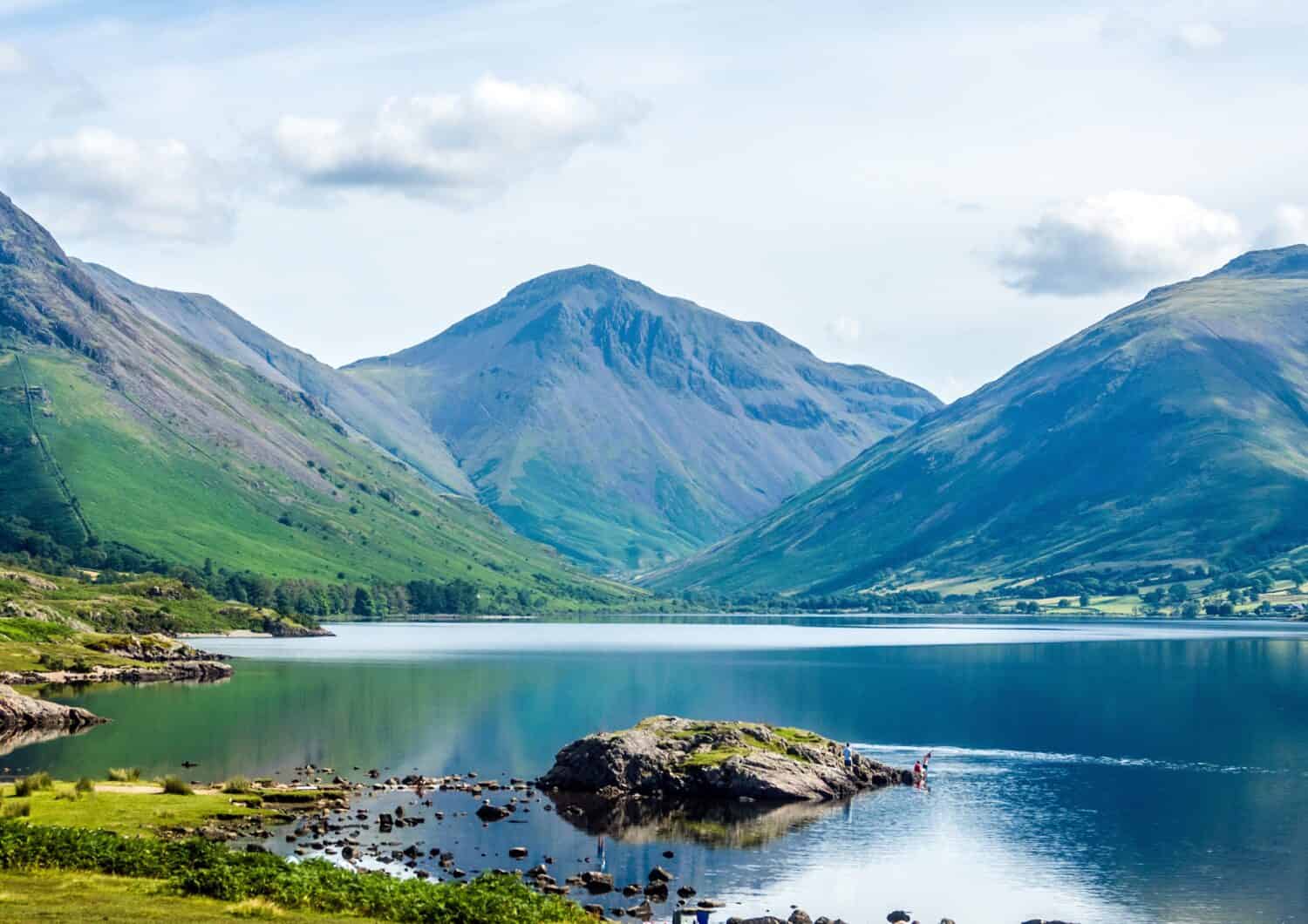How deep is the deepest lake in England? This is a great question, as there are over 40,000 lakes across the United Kingdom. 390 lakes in England proper total 5 hectares or more. One hectare is equivalent to 2.47 acres, so the 390 lakes we mention all total 12.3 acres or more in surface area. Of these 390 lakes, one stands out in terms of depth. We’re going to take a look at that lake and the region around it. To avoid confusion, we’ll state now that the deepest is not equivalent to the largest. The lake we will be talking about today is surely the deepest lake in England, but it is not the largest. Let’s dive right in and learn more about England’s deepest lake.
What is the Deepest Lake in England?

A view of Wast Water, with Scafell Pike looming in the distance.
©nikonpete/Shutterstock.com
The deepest lake in England is Wast Water (or Wastwater) at a maximum depth of 258 feet. This lake rests in the Lake District of England – Cumbria. The Lake District is both a region and a national park. This ceremonial non-metropolitan county is located in the northwestern portion of England with its northern reaches defining the Scottish border. The Irish Sea creates its western border, while counties Northumberland and Durham shape it to the east. North Yorkshire borders the region to the southeast and Lancashire borders it to the south.
The depth of this lake quite greatly exceeds the depths of other lakes in England. For example, the second-deepest lake in England – Lake Windermere – is only 219 feet. That’s a 39-foot difference! That’s a difference of about half of a standard tennis court. Do you want another size comparison? The international average height of an adult human is 5 feet, 7 inches. We don’t spend too much time stacking humans, but 7 full humans stacked atop one another would fit (with room to spare) in this depth difference.
Other lakes in England with notable depths include Ullswater (207 feet), Haweswater (187 feet), and Coniswater (184 feet). You should keep in mind that we are referencing the maximum depth of each lake. Wast Water is still deep by that metric with an average depth of about 130 feet!
The lake is also 3 miles long and about half a mile wide.
Wast Water on a Map
Do you want to see Wastwater on a map? You’re in luck – we’ve included a handy interactive map of the lake to show you where it sits in England. Here’s a cool fact to note on the map: Scafell Pike is the highest and most prominent mountain in England. You can see that this mountain towers over the lake to the northwest. What you can’t see is its actual height. Scafell Pike is 3,209 feet above sea level. Even more impressively, the majority of the mountain is prominent. Prominence refers to the height of a mountain’s summit in relation to its surrounding landscape, whereas overall elevation refers to the height of a mountain’s summit from sea level. The prominence of Scafell Pike is 2,992 feet. In comparison, the surface elevation of Wast Water is 200 feet above sea level.
The lake is only ten miles from the western coast of England.
More About Wast Water
There is a lot to know about this beautiful lake, so we’ll cover a few key basics in this section.
Wast Water is a famous diving spot in England. The depth and clarity of the mountain lake draw avid divers from around the world to explore its depths. Gary Dallas is one such diver, and he shows video and imagery of the lake and the dive with help from drones and other divers. In this video, you can see some of the items hidden at the bottom of the lake, including a garden gnome village. Another diver, Andy the Northern Diver, shows even more underwater dive footage. He warns that these dives are high risk – there is no diving support on the lake. You have to attain a dive permit to be allowed to dive and, even then, you must bring all of your own gear, support, and transportation. Several divers have drowned while attempting this dive.
The water is so clear, in part, because it is so cold. Even the hottest summer days can’t warm the waters significantly. Swimmers and divers alike should take care to note the temperature of the water before taking a dip. Because of its size, geography, beauty, and clarity, Wast Water earned the honor of being named one of the 7 Natural Wonders of the United Kingdom by the Royal Geographical Society in 2021. Speaking of geographical beauty, let’s explore a little more of the geography of Wast Water.
Geography

The ridge leading from Scafell Pike to Sca Fell. This mountainous area deeply influences the geography of Wast Water itself.
©Drew Rawcliffe/Shutterstock.com
Wast Water rests in a valley surrounded by mountainous terrain. It is a glacial lake, which means it formed as a result of glacial shifts and melts. This glacial activity over-deepened the valley, resulting in the formation of the lake. The lake has interesting features due to this method of formation. It is surrounded by “screes” – masses of small to medium loose stones that make up or define mountain slopes. These menacing-looking screes create a stunning backdrop to the lake’s beauty and rise to tower up to 2,000 feet above its waters. The rocks are dominantly black but are tinged with streaks of red from iron deposits in the mountains.
The lake itself naturally lacks minerals and nutrients. In fact, biologists describe Wast Water as “oligotrophic”. This means that the lake has very little plant life and a dense amount of oxygen in its deeper reaches. The result of this natural occurrence is limited habitability. Very few species swim in the lake because it has little to offer in terms of food and nutrient sources. However, a few species of animal still do call it home. Brown trout, Arctic char, and a variety of eel all swim in Wast Water.
The bottom of the lake is rich in sediment deposits. Divers warn that reaching further depths in some areas results in limited visibility and poor diving conditions.
Wildlife in the Valley

Peregrine falcons fly high above the lake.
©Harry Collins Photography/Shutterstock.com
The valley that Wast Water rests in is home to several animal species, including very rare ones. The same is true of the mountains that tower around the lake. Visitors will get the chance to see red squirrels, golden eagles, Roe deer, otters, and Herdwick sheep. Keep in mind that many of these species prefer forests and prairies. This means you may have to branch out of the valley and into the greater Lakes Region to see some of them.
Birdwatchers will have the best luck in the valley or on a climb. Incredible birds, such as osprey, peregrine falcons, red kites, kestrels, and buzzards all enjoy the mountain ranges. Go closer to forested regions to get a glimpse of woodpeckers, cuckoos, and swarms of starlings.
A variety of small mammals also wander the region. You’re not as likely to see the secretive moles and badgers that inhabit the area, but you may stumble upon foxes, rabbits, and shrews. Always keep in mind that wildlife is deeply impacted by our presence. Tread lightly and respectfully as you interact with your natural world. A variety of habitats for animals are struggling to survive in our human world, and it is our responsibility to care for the habitats that remain. Life is precious – we can protect ourselves and the world around us by practicing safe and ethical habits.
Pack out all of your trash, make sure your pets don’t disturb local wildlife, and keep a safe distance from any animals you encounter. This helps guarantee that we can continue to observe and celebrate the diversity and beauty of life on Earth.
Thank you for reading! Have some feedback for us? Contact the AZ Animals editorial team.








